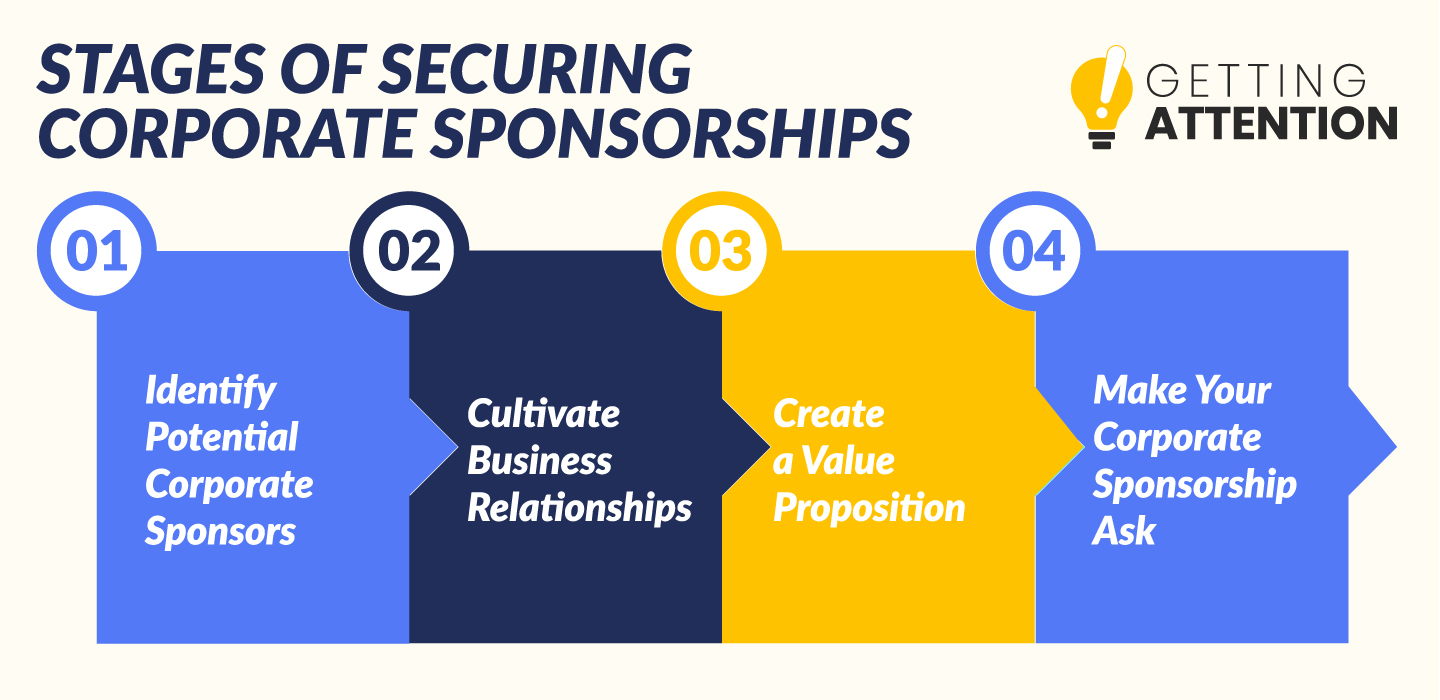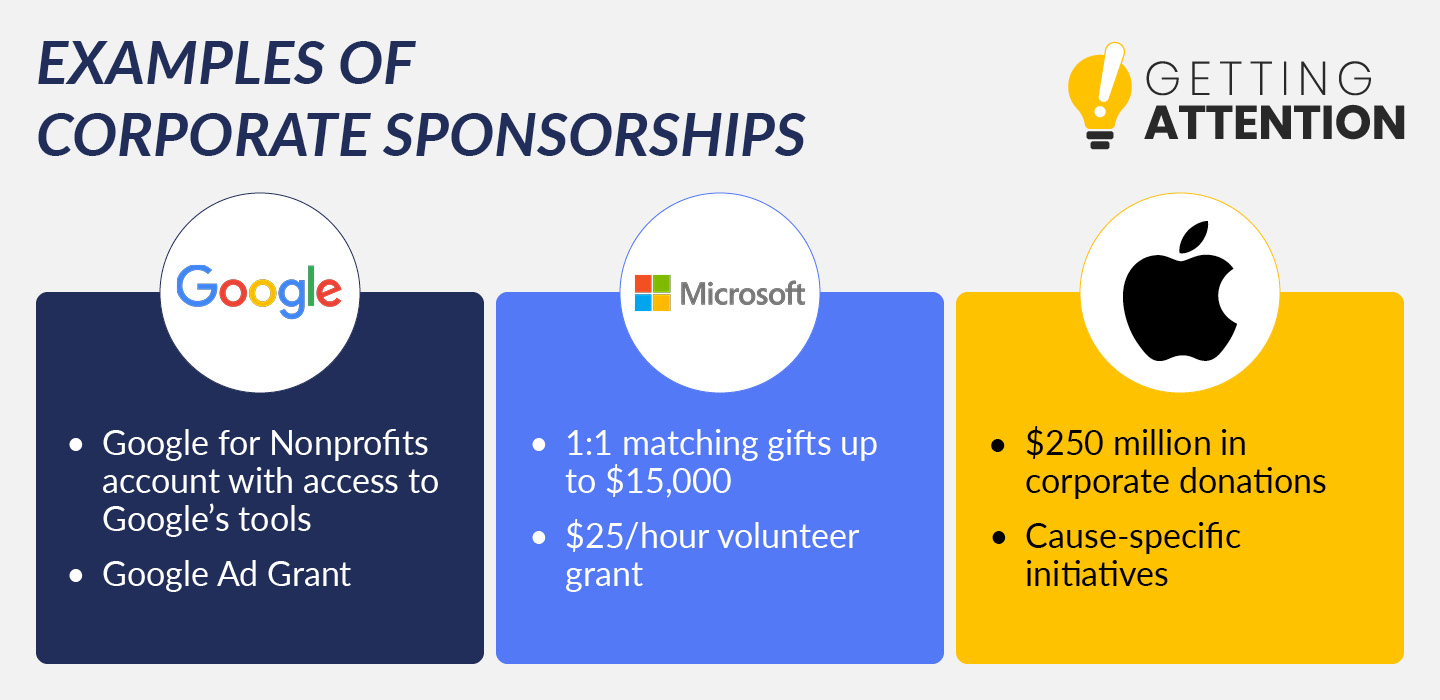Securing Corporate Sponsorships: How to Lock Down Support
As a nonprofit organization, you’re always on the lookout for new and improved ways to secure revenue for your cause. One of the most underutilized sources of nonprofit funding is corporate giving—and within that subcategory, corporate sponsorships can maximize your fundraising potential.
But what exactly are the opportunities available, and how can your team go about securing corporate sponsorships to help fund your mission? This guide will provide you with everything you need to know by exploring the following key topics:
- What Are Corporate Sponsorships?
- Who Benefits From Corporate Sponsorships?
- The Four Stages of Securing Corporate Sponsorships
- What does corporate sponsorship look like?
- How to Secure More Corporate Sponsorships: FAQ
Partnering with for-profit businesses can often be one of the most lucrative and impactful fundraising strategies for organizations of all shapes, sizes, and causes. And don’t forget—participating companies benefit greatly as well. Let’s start with the basics.
What Are Corporate Sponsorships?
Corporate sponsorships are an extremely popular form of corporate giving in which companies provide funding or resources to nonprofit partners. This often takes place in the context of a particular fundraising event, campaign, or project.
For organizations looking to diversify their funding sources by exploring new streams of revenue, sponsorships can be a great place to start. And there are different types of corporate sponsorships available, too! These include:

- Financial: A business provides a monetary contribution to a nonprofit.
- In-kind: A business provides donated goods or services to a nonprofit (these are typically, but not always, related to the business’s industry).
- Media: A business funds the promotion of a nonprofit’s upcoming event through paid advertising channels.
Regardless of the kind of sponsorship agreement between an organization and a corporate partner, the common denominator is that the nonprofit receives some sort of support from a for-profit business.
Who Benefits From Corporate Sponsorships?
Corporate sponsorships are mutually beneficial relationships, with both parties benefiting significantly from participating in the partnership. Let’s take a look at key advantages for the two primary stakeholders in a corporate sponsorship relationship:
Alt text: This graphic and the text below explain the benefits of securing corporate sponsorships for both nonprofits and businesses.
- Companies: Companies that sponsor nonprofits as part of their corporate social responsibility programs receive elevated brand reputations, public relations boosts, higher levels of employee engagement, and tax benefits.
- Nonprofits: Organizations receive increased funding for their causes through corporate donations, along with unique co-marketing opportunities and the potential for lasting relationships with businesses.
In some forms of corporate giving, there are even more beneficiaries to the partnerships—for example, the companies’ employees or the nonprofits’ donors. Employees may feel an increased sense of pride in the businesses they work for when their employers take part in philanthropy. And donors are often provided with new ways to support their favorite organizations—such as through an upcoming event sponsored by a local business.
The Four Stages of Securing Corporate Sponsorships
You understand the advantages of corporate sponsorship participation, and you’re ready to dive in. But where exactly should you start? We’ve broken the process down into four simple steps!

1. Identify Potential Corporate Sponsors
Before you can secure corporate sponsors for your cause, you need to determine who your ideal sponsors are. Although your ideal sponsor will vary depending on your mission, campaign, and funding priorities, you should consider:
- Companies with existing philanthropic initiatives. Identify companies with strong corporate social responsibility (CSR) programs, as they are more likely to have the resources and stakeholder buy-in to support causes like yours. Examine their websites and annual reports, looking for sections that specifically mention CSR software, philanthropy success stories, and community engagement.
- Local businesses in your community. Local businesses often love giving back to the communities in which they’ve established their roots. Reach out to mom-and-pop shops in your neighborhood for potential sponsorship opportunities.
- Companies you already have connections to. Do your donors, volunteers, or board members work for philanthropically-minded companies? Has a particular business supported one of your organization’s fundraising efforts in the past? These existing connections can help you get your foot in the door with potential sponsors.
- Companies whose missions align with your own. Companies with values that overlap with yours will be more inclined to support your cause. For example, if you run an animal rescue, you might want to reach out to pet supply retailers.
Compile a list of prospective corporate sponsors to provide your solicitation team with a wide array of possibilities and improve your chances of success.
2. Cultivate Business Relationships
Like with any donation request, it’s important to have an existing relationship with potential contributors before jumping into the actual solicitation of funding.
To begin developing relationships with corporate partners, consider:
- Asking a member of a prospective sponsor’s team to sit down and chat with someone from your organization and discuss missions, values, and priorities.
- Inviting a member of a prospective sponsor’s team to visit your organization’s facility for a behind-the-scenes tour.
- Providing a prospective sponsor with fundraising impact materials such as your annual report, Form 990, and more.
- Taking an interest in a prospective sponsor’s business, strategies, and goals.
Not only are you likely to win more corporate sponsors this way, but it also helps establish a sense of familiarity with each party and makes the sponsorship feel relational rather than solely transactional.
3. Create a Value Proposition
Your organization’s value proposition is essentially the answer to the business asking, “What’s in it for me?” One of the most common types of value propositions is that of co-marketing efforts and improved brand reputation. Here’s an example:
Let’s say that Linda’s Flower Mart provides funding for a fundraising event for a local nonprofit, Midtown Youth Center. To provide value for Linda’s Flower Mart, the company’s logo is featured in all marketing materials for the event as a key sponsor, ensuring a wider audience is exposed to her company and will consider her services for future flower needs. Midtown Youth Center then promotes its upcoming fundraiser through all of its marketing and communication channels.
The day after the fundraising event, Linda meets a new group of eager customers who report that they love shopping at local businesses that continue to give back to their own communities.
This value proposition is vital for securing corporate sponsorships, but keep in mind that the benefit to the corporation should not outweigh the benefit to the organization. If it does, the IRS may classify income as “unrelated business income” (taxable) as opposed to a “charitable contribution” (tax-free).
The quality of the co-marketing benefits you offer can make a big difference to sponsors. To improve your value proposition and secure more sponsors, sign up for the Getting Attention newsletter to get marketing tips in your inbox!
4. Make Your Corporate Sponsorship Ask
Now it’s time to make the actual request—and this can be the most nerve-wracking step in the process for many fundraisers. As you get to this point, consider the following best practices:
- Conduct several practice runs of sponsorship request conversations before you meet with the businesses in question.
- Have your corporate sponsorship conversations in person when possible. This makes the meeting more personal and helps put a face to your organization.
- Recruit volunteers to make the actual sponsorship ask! These individuals are not being paid to say good things about your organization, and that can make a difference for businesses considering contributing.
- Offer various sponsorship tiers that align with different-sized budgets. Many businesses will be interested in supporting your efforts but might not be able to swing the hefty price tag of a top sponsorship package.
- Emphasize your value proposition. This is the tangible benefit offered to businesses considering a partnership and should be the main focus of your conversations.
As you start these conversations, it’s also essential that your team knows how and when to take no for an answer. Some companies simply won’t be able to contribute right now—but if you leave your conversation on a positive note, they’ll be more likely to consider partnering with your organization in the future.
What does corporate sponsorship look like?
All of these strategies sound good in theory, but what does corporate sponsorship look like in the real world? There are several examples from well-known companies, such as:

- Google: If you know anything about Getting Attention, you’re already familiar with Google’s corporate philanthropy program! Google helps nonprofits reach wider audiences through Google for Nonprofits, which gives these organizations access to the Google Ad Grant application and many more collaboration and productivity tools.
- Microsoft: Microsoft matches its employees’ gifts up to $15,000. Their volunteer grant has no minimum requirement for the number of hours volunteered and donates $25 per hour served.
- Apple: According to Apple’s impact report, the company donated over $250 million in 2021. Apple also has cause-specific initiatives through which the company makes values-based investments.
For examples that are closer to home, look to your local charities. Their websites and social media promotions might highlight a local business, which is a huge indicator of corporate philanthropy! For example, if a local animal shelter was able to offer free adoptions one weekend because of a bank’s contribution, you might inquire more about the bank’s charitable donations.
How to Secure More Corporate Sponsorships: FAQ
Still have questions about securing corporate sponsorships for your nonprofit? Here are answers to some common questions organizations have throughout the process.
What should I do after securing a corporate sponsorship?
After securing corporate sponsorships, focus on solidifying your relationship with the company. Share resources about your organization’s work, additional engagement opportunities, mission success stories, and more. Make sure both teams are on the same page with what exactly the sponsorship entails, including logistics surrounding funding transfers.
Once the sponsorship concludes, continue developing your partnership with the company. Maintaining a personal relationship is essential for showing your appreciation for the company’s support. And as an added bonus, they’ll likely be more inclined to partner with your team on future endeavors!
How should we acknowledge corporate sponsors?
The ways in which your organization acknowledges its sponsors will depend on your nonprofit itself, the event or campaign being sponsored, and the company you’re partnering with. For example, if you’re hosting a community event, you might acknowledge a sponsor by providing them with a tent or other area to promote their business.
Keep in mind that some forms of public acknowledgment may be specifically laid out in the sponsorship agreement. This might include:
- Social media promotion
- Website inclusions
- Space in tangible marketing materials
- Branded event announcements
- And more
If you want to branch out and acknowledge your sponsors using an additional free marketing channel, consider utilizing the Google Ad Grant. With this resource, you can place free advertisements highlighting your campaign and your sponsor at the top of relevant Google search results pages.
What are other top corporate fundraising opportunities?
If a company has shown particular interest in philanthropy before, it might be increasingly inclined to participate in other types of corporate sponsorship. If your team is interested in additional corporate giving programs, we recommend the following:
- Matching gifts
- Volunteer grants
- Employee donation stipends
- Payroll deductions
- Community grants
Be sure to note that various forms of corporate giving opportunities often tend to overlap! For instance, studies show that 85% of the top matching gift companies also offer volunteer grant programs for their employees.
Not to mention, your organization can also work directly with a company to craft a dedicated partnership that aids both teams in reaching their goals. One of the best examples of this would be a custom matching gift program. Even if a company doesn’t offer a widely available donation-matching initiative, its leadership may decide it’s ready to test the waters with a limited-scale program—such as by matching employee donations solely to your nonprofit cause.
Additional Corporate Sponsorship Resources
Now that you have a solid foundation for how to locate opportunities and propose partnerships, you’re ready to get started. But your efforts in securing corporate sponsorships on behalf of your organization are just beginning!
Interested in learning more? Explore other top corporate fundraising resources here:
- 14 Important Questions to Ask About Matching Gifts. Corporate matching and sponsorships go hand in hand. Dive into the importance of matching gifts and how to increase your organization’s revenue through this source.
- Corporate Volunteer Grants: The Basics & How to Secure Them. The companies you partner with to secure corporate sponsorships may also have volunteer grant programs—learn how you can benefit from these opportunities as well.
- Digital Marketing for Nonprofits: A Complete Guide. Learn basic marketing strategies you can use to offer more value to your corporate sponsors.





